The GeForce GTX 660 Ti Review, Feat. EVGA, Zotac, and Gigabyte
by Ryan Smith on August 16, 2012 9:00 AM ESTPower, Temperature, & Noise
As always, we’re wrapping up our look at a video card’s stock performance with a look at power, temperature, and noise. Like we discussed in the introduction, while the official TDP of the GTX 660 Ti is 150W – 20W lower than the GTX 670 – the power target difference is only 7W. So let’s see which is more accurate, and how that compares to AMD’s cards.
| GeForce GTX 660 Ti Voltages | ||||
| Zotac GTX 660 Ti Boost Load | EVGA GTX 660 Ti Boost Load | Gigabyte GTX 660 Ti Boost Load | ||
| 1.175v | 1.162v | 1.175v | ||
Stopping to take a quick look at voltages, there aren’t any big surprises here. NVIDIA would need to maintain the same voltages as the GTX 670 because of the identical clocks and SMX count, and that’s exactly what has happened. In fact all single-GPU GK104 cards are topping out at 1.175v, NVIDIA’s defined limit for these cards. Even custom cards like the Gigabyte still only get to push 1.175v.
Up next, before we jump into our graphs let’s take a look at the average core clockspeed during our benchmarks. Because of GPU boost the boost clock alone doesn’t give us the whole picture – particularly when also taking a look at factory overclocked cards – we’ve recorded the clockspeed of our video cards during each of our benchmarks when running them at 2560x1600 and computed the average clockspeed over the duration of the benchmark. Unfortunately we then deleted the results for the factory overclocked cards, so we only have the “reference” card. Sorry about that guys.
| GeForce GTX 600 Series Average Clockspeeds | |||||||
| GTX 670 | GTX 660 Ti | Zotac GTX 660 Ti | EVGA GTX 660 Ti | Gigabyte GTX 660 Ti | |||
| Max Boost Clock | 1084MHz | 1058MHz | 1175MHz | 1150MHz | 1228MHz | ||
| Crysis | 1057MHz | 1058MHz | N/A | ||||
| Metro | 1042MHz | 1048MHz | |||||
| DiRT 3 | 1037MHz | 1058MHz | |||||
| Shogun 2 | 1064MHz | 1035MHz | |||||
| Batman | 1042MHz | 1051MHz | |||||
| Portal 2 | 988MHz | 1041MHz | |||||
| Battlefield 3 | 1055MHz | 1054MHz | |||||
| Skyrim | 1084MHz | 1045MHz | |||||
| Civilization V | 1038MHz | 1045MHz | |||||
The average clockspeeds on our “reference” GTX 660 Ti don’t end up fluctuating all that much. With a max boost of 1058 the card actually gets to run at its top bin in a few of our tests, and it isn’t too far off in the rest. The lowest is 1035 for Shogun 2, and that’s only an average difference of 22MHz. The GTX 670 on the other hand had a wider range; a boon in some games and a bane in others. If nothing else, it means that despite the identical base and boost clocks, our cards aren’t purely identical at all times thanks to the impact of GPU boost pulling back whenever we reach our power target.
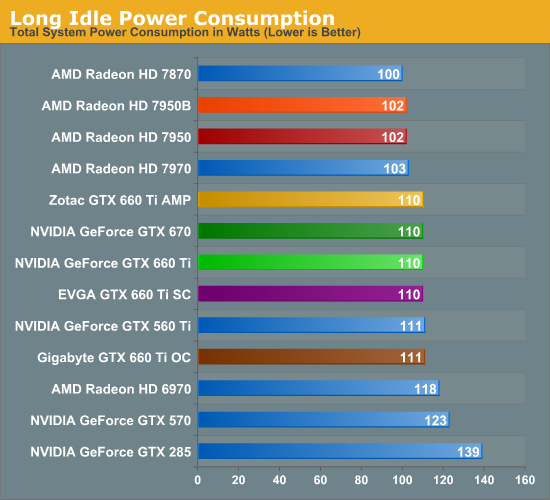
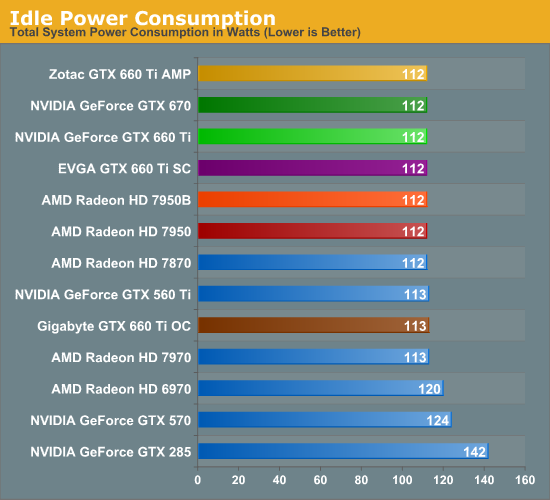
There are no great surprises with idle power consumption. Given the immense similarity between the GTX 670 and GTX 660 Ti, they end up drawing the same amount of power both during idle and long idle. This does leave AMD with an 8W-10W lead at the wall in this test though.
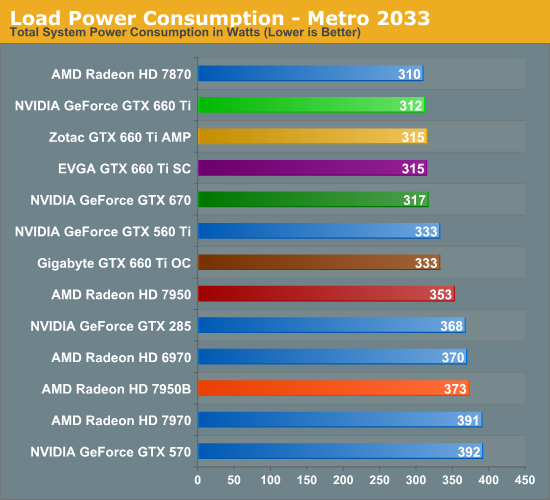
Moving on to our load power tests we start with Metro: 2033. As we mentioned previously the GTX 660 Ti and GTX 670 have very similar power targets, and this benchmark confirms that. Power consumption for the GTX 660 Ti is virtually identical to the Radeon HD 7870, an interesting matchup given the fact that this is the first time NVIDIA has had to compete with Pitcairn. Pitcairn’s weaker compute performance means it starts off in a better position, but it looks like even with a salvaged GK104 NVIDIA can still compete with it. NVIDIA drove efficiency hard this generation; to compete with a smaller chip like that is certainly a testament to that efficiency.
As for the inevitable 7950 comparison, it’s no contest. The GTX 670 was already doing well here and the GTX 660 Ti doesn’t change that. Tahiti just can’t match GK104’s gaming efficiency, which is why AMD has had to push performance over power with the new 7950B.
Meanwhile it’s fascinating to see that the GTX 660 Ti has lower power consumption than the GTX 560 Ti, even though the latter has the advantage of lower CPU power consumption due to its much lower performance in Metro. Or better yet, just compare the GTX 660 Ti to the outgoing GTX 570.
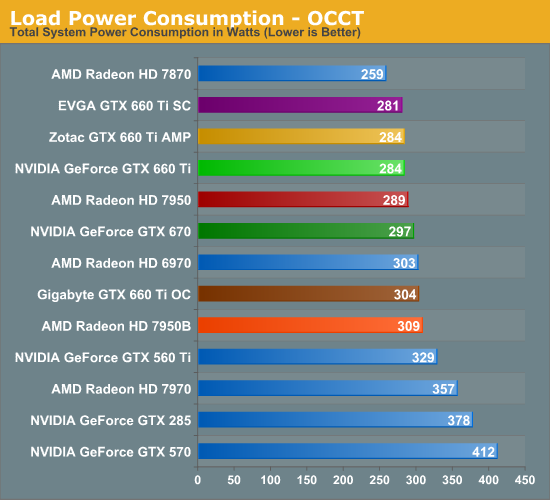
For AMD/NVIDIA comparisons we have a bit less faith in our OCCT results than we do our Metro results right now, as NVIDIA and AMD seem to clamp their power consumption differently. NVIDIA’s power consumption clamp through GPU Boost is far softer than AMD’s PowerTune. As a result the 7870 consumes 25W less than the GTX 660 Ti here, which even with AMD’s very conservative PowerTune rating seems like quite the gap. Metro seems to be much more applicable here, at least when you’re dealing with cards that have similar framerates.
In any case, compared to NVIDIA’s lineup this is another good showing for the GTX 660 Ti. Power consumption at the wall is 45W below the GTX 560 Ti, a large difference thanks to the latter’s lack of power throttling technology.
As for our factory overclocked cards, these results are consistent with our expectations. Among the Zotac and EVGA cards there’s a few watts of flutter at best, seeing as how they have the same power target of 134W. Meanwhile the Sapphire card with its higher power target is 20W greater at the wall, which indicates that our estimated power target of 141W for that card is a bit too low. However this also means that those times where the Gigabyte card was winning, it was also drawing around 20W more than its competition, which is a tradeoff in and of itself.
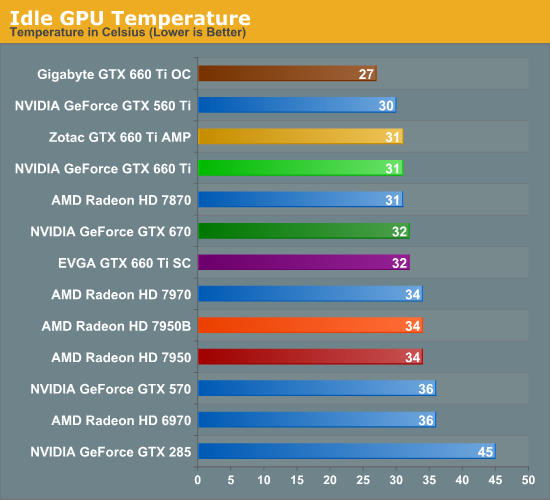
Moving on to temperatures, at 31C the GTX 660 Ti is once more where we’d expect it to be given the similarities to the GTX 670. Open air coolers tend to do a bit better here than blowers though, so the fact that it’s only 1C cooler than the blower-type GTX 670 is likely a reflection on Zotac’s cooler.
Speaking of factory overclocked video cards, one card stands out above the rest: the Gigabyte GTX 660 Ti. That oversized cooler does its job and does it well, keeping the GPU down to barely above room temperature.
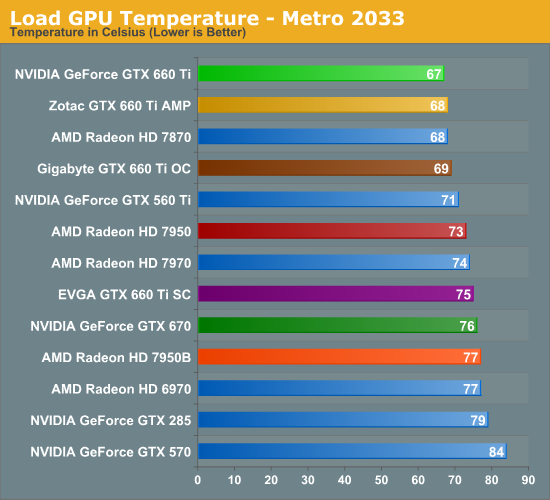
Considering that most of our high-end cards are blowers while our “reference” GTX 660 Ti is an open air cooler, temperature benchmarks are the GTX 660 Ti’s to win, and that’s precisely what’s going on. 67C is nice and cool too, which means that the open air coolers should fare well even in poorly ventilated cases.
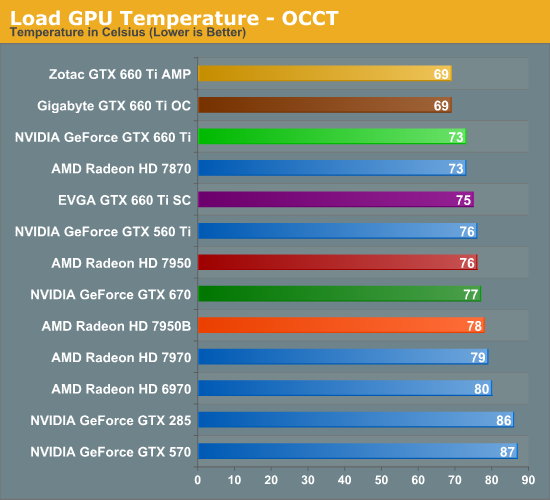
As usual we see a rise in temperatures when switching from Metro to OCCT, but at 73C the GTX 660 Ti is still the coolest reference (or semi-reference) card on the board. To be honest we had expected that it would beat the 7870, but as far as blowers go the 7870’s is quite good.
Moving on to our factory overclocked cards, we’re seeing the usual divisions between open air coolers and blowers. The blower-based EVGA card performs almost identically to the GTX 670, which makes sense given the similarities between the cards. Meanwhile the open air Zotac and Gigabyte cards are neck-and-neck here, indicating that both cards are shooting for roughly the same temperatures, keeping themselves below 70C. Though it’s somewhat weird to see the factory overclocked Zotac card end up being cooler than its reference-clocked self; this appears to be a product of where the fan curve is being hit.
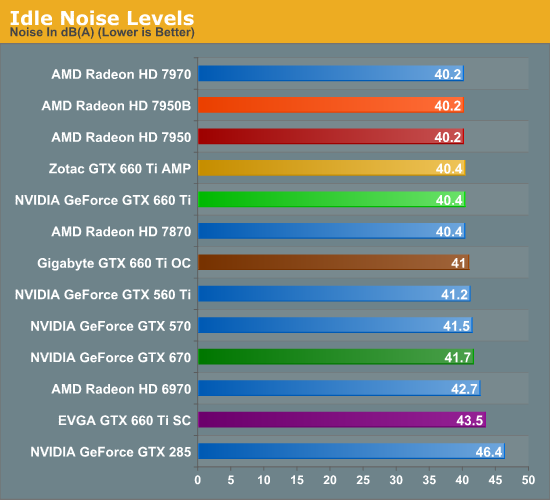
Last but not least we have our look at noise, where we’ll hopefully be able to fully shake out our factory overclocked cards.
Right off the bat we see the blower-based EVGA struggle, which was unexpected. It’s basically the same cooler as the GTX 670, so it should do better. Then again the EVGA GTX 670 SC had the same exact problem.
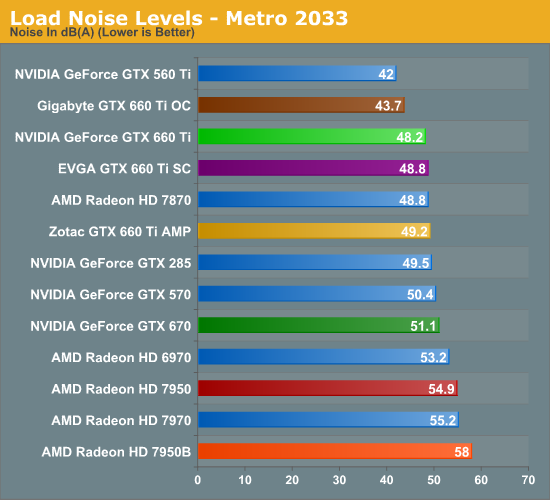
As for Metro, the GTX 660 Ti once again looks good. 48.2 isn’t the best for an open air cooler, but it’s a hair quieter than the 7870 and notably quieter than the GTX 670. The only unfortunate part about these results is that it just can’t beat the GTX 560 Ti; in fact nothing can. For its power consumption the GTX 560 Ti was an almost unreal card, but it’s still a shame the GTX 660 Ti can’t be equally unreal.
Moving on to our factory overclocked cards however, the Gigabyte GTX 660 Ti OC gets very close thanks to its very large cooler. 43.7dB technically isn’t silent, but it just as well should be. To offer the performance of a GTX 660 Ti (and then some) in such a package is quite the accomplishment.
As for Zotac and EVGA, there’s nothing bad about either of them but there’s also nothing great. EVGA’s card is about average for a blower, while Zotac’s card seems to be suffering from its size. It’s a relatively tiny card with a relatively tiny cooler, and this has it working harder to hit its temperature targets.
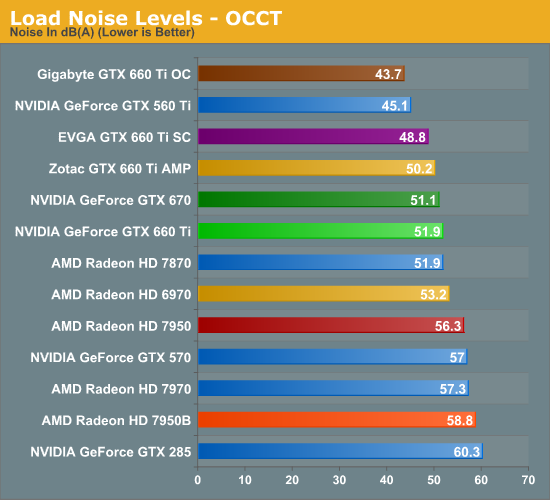
Finally we have noise testing with OCCT. Our “reference” GTX 660 Ti actually fares a bit worse than the GTX 670, which is unfortunate. So much of this test comes down to the cooler though that it’s almost impossible to predict how other cards will perform. At least it’s no worse than the 7870.
Meanwhile the Gigabyte GTX 660 Ti OC continues to impress. 43.7dB not only means that it didn’t get any louder switching from Metro to OCCT, but it has now bested the GTX 560 Ti thanks to the 560’s lack of power throttling technology. Make no mistake, 43.7dB for this kind of performance is very, very impressive.
As for EVGA and Zotac, it’s also a rehash of Metro. EVGA’s blower is actually over 1dB quieter than Zotac’s cooler, which is an unfortunate outcome for an open air cooler.
Wrapping things up, even without a true reference sample from NVIDIA it’s clear that the GTX 660 Ti has a lot of potential when it comes to power/temp/noise. Compared to other cards it’s roughly equivalent in power consumption and noise to the 7870, which for NVIDIA is an important distinction since it’s also notably faster than the 7870, so NVIDIA is on a better place on the power/performance curve. This goes for not only the 7870, but especially the 7950, where the GTX 660 Ti continues the tradition the GTX 670 already set, which will see the GTX 660 Ti being cooler, quieter, and less power hungry than AMD’s entry-level Tahiti part.
But it must be pointed out that the lack of a reference design for the GTX 660 Ti means buyers are also facing a lot of variability. Power consumption should be consistent between cards – which is to say a hair less than the GTX 670 – but temperature and especially noise will vary on a card by card basis. Potential buyers would best be served by checking out reviews ahead of time to separate the duds from the gems.










313 Comments
View All Comments
TheJian - Sunday, August 19, 2012 - link
http://www.newegg.com/Product/Product.aspx?Item=N8...And it's $350. The only BOOST edition on newegg 2 days after this review.
A full 6 660 TI's for $299 (one after rebate). So, unfair to not include a card that looks like there's a $50 premium to the TI? I beg to differ. Also there are 11 cards available to BUY for 660 TI. Nuff said?
It was rightly picked on.
Google 7950 boost, you get $349 cheapest and availability is next to none. Google 7950b you don't even get a result for shopping. The radeon 7950 cheapest at newegg is already $319.99 (most after rebate). If you're looking at 1920x1200 and below the 660 TI is a no brainer. It is close in the games it loses in, and dominates in a few it wins in. Not sure why the nvidia 660 ti is even in the list, you don't buy that. Zotac's $299 is basically the bottom you buy and is faster than the ref design at 928mhz/1006 boost (not 915/boost 980), so consider the TI GREEN bar slower than what you'll actually buy for $299. Heck the 6th card I mentioned at $299 after rebate is running it's base at 1019 boost at 1097! So they are clocking regular cards at a full 100mhz faster than REF for $299. Another at $309 is also like this (1006/1084 boost). Knowing this you should be comparing the Zotac AMP (barely faster than the two I mention for $299 and 309) vs. the 7950 which is $320 at minimum!
Zotac AMP (only 14mhz faster base than $299/309 card) vs. 7950 (again more expensive by $20) @ 1920x1200
Civ5 <5% slower
Skyrim >7% faster
Battlefield3 >25% faster (above 40% or so in FXAA High)
Portal 2 >54% faster (same in 2560x...even though it's useless IMHO)
Batman Arkham >6% faster
Shogun 2 >25% faster
Dirt3 >6% faster
Metro 2033 =WASH (ztac 51.5 vs. 7950 51...margin of error..LOL)
Crysis Warhead >19% loss.
Power@load 315w zotac amp vs. 353 7950 (vs 373w for 7950B)! Not only is the 660TI usually faster by a whopping amount, it's also going to cost you less at the register, and far less at the electric bill (all year for 2-4 years you probably have it - assuming you spend $300-350 for a gaming card to GAME on it).
For $299 or $309 I'll RUN home with the 660 TI over 7950 @ $319. The games where it loses, you won't notice the difference at those frame rates. At todays BOOST prices ($350) there really isn't a comparison to be made. I believe it will be a while before the 7950B is $320, let along $299 of the 660 TI.
NVIDIA did an awesome job here for gamers. I'll wait for black friday in a few months, but unless something changes, perf/watt wise I know what I'm upgrading to. I don't play crysis much :) (ok, none). Seeding higher clocked cards or not, you can BUY them for $299, can't buy a BOOST for under $350. By your own account, only two makers of 7950 BOOST. Feel free to retract your comment ;)
CeriseCogburn - Sunday, August 19, 2012 - link
NO ONE plays crysis anymore, it's merely a placeholder to prop up AMD card stats. It's blatantly sick as Crysis 2 is out.It's IMMENSE bias for amd.
Galidou - Sunday, August 19, 2012 - link
They use Crysis 2 almost everywhere on the internet again because of one reason, it's heavy, no one plays 3dMark because it's not a game still it's always included in reviews because it's relevant to performance.TheJian - Monday, August 20, 2012 - link
Read it again...He said NOBODY plays CRYSIS. He's confirming what I said.The complaint wasn't about crysis 1...It was about benchmarking a game from 2008 that isn't played, and is based on CryEngine 2 which a total of 7 games were based on since 2007. Crysis 1, warhead, Blues Mars (what? Not one metacritic review), Vigilance (what? no pc version),Merchants of Brooklyn, no reviews, The Day (?) and Merchants of Brooklyn,(?) Entropia Brooklyn (?). Who cares?
The complaint is Anantech should use CRYSIS 2! With the hires patch and DX11 patch, with everything turned on. The CryEngine 3 game engine is used in 23 games, including the coming crysis 3! Though after a little more homework I still think this will be a victory for AMD, it's far more relevant and not a landslide by any means. But it IS relevant NV loser or not. Crysis 2 is still being played and I'm sure crysis 3 will for at least a while soon. 3x the games made on this engine...Warhead should be tossed and Crysis 2 used. But not without loading the 3 patches that get you all this goodness.
Galidou - Monday, August 20, 2012 - link
Well I meant Crysis, not the 2, confused there. Even if no one plays the first one it's still very intensive but true, they should use crysis 2 as it's more relevant of games played now...CeriseCogburn - Thursday, August 23, 2012 - link
Yes we all play 3dmark and upload our scores and compare.Not sure about you, you only play one game that now conveniently got an amd driver boost.
Good for amd they actually did something for once - although i'll be glad to hear how many times it crashes for you each night @ 1300 WC.
It will be a LOT. Believe me. 30 mods, not as many as myself, but you'll be going down with CCC often.
Galidou - Thursday, August 23, 2012 - link
Of all the video cards I had, and I had ALOT from the geforce 2 GTS up to my actually retreated 6850 crossfire(just received my Sapphire 7950 OC) I had close to 0 problems. How could you know anything about CCC while it's obvious you didn't have an AMD video card in years.I have 30 mods because it was already straining my limited video memory and I had a problem with one of them already(realistic sounds of thunder) which was related to my hi-fi sound card driver(asus xonar STX) that I found lately.
I had no problem with CCC at all, other than using it to scale my LCD TV so it fits all the screen and using my game profiles. I didn't touch it much in the last year. It played Dirt 2, 3, Skyrim, GTA 4, Fallout 3, Fallout NV, Oblivion!!, and so on without a problem. And yet, you try to tell me I'll have problem with a program you don't know a thing about.
But just so you might appreciate me for my efforts, my wife decided to change the 4870 for the forthcoming Guild wars 2 for energy and temperature reason. So I got her a 660 ti as my 6850 were already sold to a friend. She game at 1080p only and I didn't want to overclock her stuff so, it was obvious. At the same time I'll be able to compare both, but I already know I like Nvidia's UI more than AMD's CCC though they look quite alike now.
BTW just for the sake of it I researched with google:
AMD drivers keep crashing:
3,54 million results
Nvidia drivers keep crashing:
3,37 million results
CeriseCogburn - Thursday, August 23, 2012 - link
The reason I say what I do is because I DO HAVE A LOT of amd cards, you DUMMY.CeriseCogburn - Thursday, August 23, 2012 - link
you're another idiot that gets everything wrong, attacks others for what they HAVE NOT SAID, gets corrected again and again, makes another crap offshot lie, then, OF COURSE - HAS A PERFECT DUAL AMD SETUP THAT HAS NEVER HAD A PROBLEM, EVA!That means you have very little experience, a freaking teensy tiny tiny bit.
Look in the mirror dummy.
Galidou - Sunday, August 19, 2012 - link
The 7950b is crap, I don't even want to hear about a reference design with a little boost. On newegg there are 4 cards out of 18 that are reference and the others are mainly overclocked models with coolers ALOT better which will overclock terribly good.It's easy for the average user to see the win for nvidia considering 20% of the overclock has been already done and there's not much headroom left..... Once overclocked, the only one that's faster for the 660 ti, remains portal 2.
The Zotac might only have 14mhz more on base clock but the core clock is not the thing here, the zotac is the better of the pack because it comes with memory overcloked to 6,6ghz which is the only weakness of the 660ti, memory bandwidth. There's a weird thing in here tho, I found the minimum fps on another review, but on anandtech, the minimum appeared only in the games that it was less noticeable, good job again Nvidia.